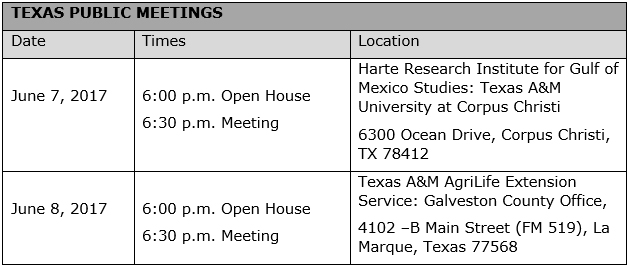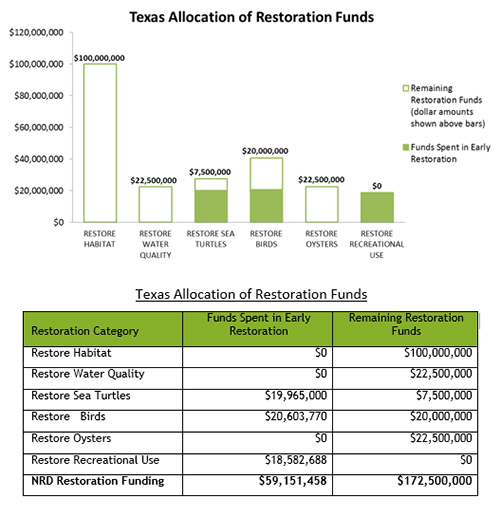Government Trustees Restoring the Gulf (NRDA)
Deepwater Horizon Oil Spill Texas Trustees Release Restoration Plan for Texas Gulf Coast
The Texas Trustee Implementation Group (TIG) has released its first restoration plan, selecting 13 restoration projects to compensate for injuries to natural resources caused by the Deepwater Horizon oil spill. The Texas Trustee Implementation Group Final 2017 Restoration Plan and Environmental Assessment: Restoration of Wetlands, Coastal, and Nearshore Habitats; and Oysters was published on October 18, 2017 and prioritizes restoration projects for oysters and wetlands, coastal, and nearshore habitats with a total estimated cost of $45,761,000.
The 13 selected projects include:
- Bird Island Cove Habitat Restoration Engineering, Galveston Bay System
- Essex Bayou Habitat Restoration Engineering, Galveston Bay System
- Dredged Material Planning for Wetland Restoration, Texas Coast
- McFaddin Beach and Dune Restoration, Sabine Lake Area
- Bessie Heights Wetland Restoration, Sabine Lake Area
- Pierce Marsh Wetland Restoration, Galveston Bay System
- Indian Point Shoreline Erosion Protection, Corpus Christi Bay System
- Bahia Grande Hydrologic Restoration, Lower Laguna Madre
- Follets Island Habitat Acquisition, Galveston Bay System
- Mid-Coast Habitat Acquisition, Matagorda County
- Bahia Grande Coastal Corridor Habitat Acquisition, Lower Laguna Madre
- Laguna Atascosa Habitat Acquisition, Lower Laguna Madre
- Oyster Restoration Engineering, Galveston Bay System
The final restoration plan reflects revisions to the draft plan resulting from public comments and continuing project development by the Texas TIG. In light of the recent impacts to the coast by Hurricane Harvey, the Trustees re-evaluated the proposed preferred project sites and determined that environmental coastal conditions did not change sufficiently to warrant a change in the suite of projects selected in this restoration plan.
For more information about ongoing restoration efforts in Texas or to view this restoration plan, visit NOAA’s Texas Restoration Plan webpage.
Texas Trustees Propose New Restoration Plan for Texas Gulf Coast
The Texas Trustee Implementation Group (TIG) is working to restore the Texas coast along the Gulf of Mexico after the Deepwater Horizon oil spill and is seeking public comment on the Deepwater Horizon Oil Spill Texas Trustee Implementation Group Draft 2017 Restoration Plan and Environmental Assessment: Restoration of Wetlands, Coastal, and Nearshore Habitats; and Oysters. The draft plan, published May 18, 2017, proposes a suite of restoration projects to compensate for injuries to natural resources caused by the Deepwater Horizon oil spill. The Texas TIG reviewed more than 800 restoration projects suggested by the public, state and federal agencies, and other various stakeholders. Of these projects, the Texas TIG proposes 13 preferred projects in the draft restoration plan and environmental assessment. The natural resource damage assessment funds allocated to the Texas Restoration Area— with more than $175 million remaining in unallocated funds —are to be used to restore and conserve wetlands, coastal, and nearshore habitats, restore water quality through nutrient reduction, as well as replenish and protect sea turtles, birds, and oysters. For this draft plan, the Texas TIG prioritized restoration projects for wetlands, coastal, and nearshore habitats and oysters.
In identifying projects to include in the draft plan, the Texas TIG considered multiple factors including:
• federal Oil Pollution Act evaluation standards;
• restoration goals and other objectives identified in the 2016 Deepwater Horizon Oil Spill: Final Programmatic Damage Assessment and Restoration Plan and Final Programmatic Environmental Impact Statement; and
• the current and future availability of funds under the Deepwater Horizon natural resource damage assessment settlement.
The draft plan is available for public review and comment through June 19, 2017. Anyone can review the draft plan and submit comments at http://www.gulfspillrestoration.noaa.gov/restoration-areas/texas. The plan will be available at public meetings in Galveston and Corpus Christi. Details regarding the public meetings are below.
All public meetings will begin with an interactive open house where the public can ask questions and learn details of proposed projects. The open house will be followed by a formal presentation and opportunity for the public to provide comments on the draft plan.

Texas Trustee Implementation Group Calls Reviewing Restoration Project Proposals
The Texas Trustee Implementation Group (TIG) is preparing for the next phase of restoration planning, which will ultimately result in the release of a draft restoration plan and associated National Environmental Policy Act (NEPA) documents for public review and comment in the spring of 2017. In the meantime, the Texas TIG is reviewing restoration proposals that were submitted by the August 31, 2016 deadline.
Approximately $47.6 million is currently available for restoration project funding in Texas this year. In addition, over the next 15 years, the Texas TIG will receive approximately $124.8 million in additional restoration funding. The current restoration planning effort may utilize all or part of these funds. The Texas TIG may propose both discrete restoration projects as well as one or more programmatic restoration efforts. Each of the projects and programmatic efforts may require multiple years to complete and they may be funded in part by restoration funds received in the future.
Restoration funds allocated to the Texas TIG must be used for five specific restoration types. Early Restoration projects are already funding bird and sea turtle restoration types. Therefore, the Texas TIG is prioritizing current restoration planning efforts on restoration types that were not addressed previously: 1) restore and conserve wetland, coastal, and nearshore habitats; 2) restore water quality through nutrient reduction (nonpoint source); and 3) replenish and protect oysters. The Texas TIG will also consider projects for engineering and design that focus on the three restoration types mentioned above. The focus will be on these restoration categories, however the Texas TIG will continue to consider any important opportunities for additional restoration and protection of avian resources and sea turtles.
The Texas TIG is reviewing new projects and projects already submitted through the NOAA Gulf Spill Restoration website or NRDA or NFWF projects previously submitted on this website. All projects will be evaluated using the criteria established in the NRDA regulations (15 CFR 990.54).
DWH NRDA Background
A federal district court in New Orleans entered a consent decree resolving civil claims against BP arising from the April 20, 2010 Macondo well blowout and the massive oil spill that followed in the Gulf of Mexico.
Under this settlement, BP has agreed to pay the Trustees for Deepwater Horizon Natural Resource Damage Assessment up to $8.8 billion for restoration to address natural resource injuries. The chart and table below show the restoration funding allocated to the Texas Restoration Area for each restoration goal. Note that some restoration categories have been fully addressed in Early Restoration; the remaining restoration funds will be allocated over the next 15 years. For more information on the allocation of funds, please visit the Department of Justice Deepwater Horizon page.

The Trustees finalized the Programmatic Damage Assessment and Restoration Plan and Programmatic Environmental Impact Statement (PDARP/PEIS) in February 2016. The plan identifies the types of restoration needed to compensate the public for impacts to natural resources that resulted from the oil spill. Read the Restoration plan and impact statement documents, including the record of decision.
To manage restoration activities identified as part of the settlement, a Trustee Implementation Group (TIG) was assigned for each of seven restoration areas (restoration in each of the five Gulf States, the Open Ocean, and Region-wide). The Texas TIG includes representatives of each state Natural Resource Trustee agency, including the Texas Parks and Wildlife Department (TPWD), the Texas Commission on Environmental Quality (TCEQ), and the Texas General Land Office (GLO) along with our federal partners, the U.S. Environmental Protection Agency (EPA), the U.S. Department of Agriculture (USDA), the National Oceanic and Atmospheric Administration (NOAA), and the U.S. Department of the Interior (DOI).
About NRDA
A Natural Resource Damage Assessment (NRDA) is a scientific and legal process to determine natural resource damages and hold responsible parties accountable. Certain government agencies charged with trusteeship of natural resources act on behalf of the public with responsible parties to assess damages and implement restoration. In Texas, Texas Parks & Wildlife Department (TPWD), Texas General Land Office (GLO), and Texas Commission on Environmental Quality (TCEQ) act as state natural resource trustees. There are also federal agencies designated as trustees for natural resources, including the National Oceanic and Atmospheric Administration (NOAA) and Department of the Interior (DOI). For the Deepwater Horizon NRDA, the Environmental Protection Agency (EPA) and U.S. Department of Agriculture (USDA) are also designated as trustees.
Federal law requires the responsible parties to compensate for the injury to natural resources caused by the DWH oil spill. In 2011, BP agreed to participate in an early restoration process up to a cost of $1 billion. In this process, early restoration projects are selected and implemented upon agreement between BP and the trustees, pursuant to an Early Restoration Framework Agreement and applicable laws and regulations.
For more complete information about the DWH NRDA: www.gulfspillrestoration.noaa.gov.
View a list of Texas early restoration projects.
The trustees continue to actively seek public input on restoration projects.
Information on review periods and timeframes associated with funding are posted on this website as it becomes available. Please check periodically for application-related announcements.
